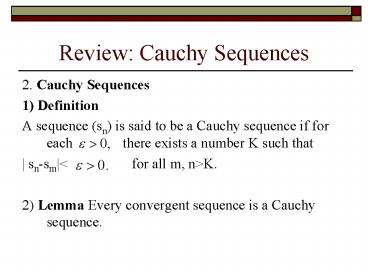Review: Cauchy Sequences PowerPoint PPT Presentation
1 / 18
Title: Review: Cauchy Sequences
1
Review Cauchy Sequences
- 2. Cauchy Sequences
- 1) Definition
- A sequence (sn) is said to be a Cauchy sequence
if for each there exists a number K
such that - sn-smlt for all m, ngtK.
- 2) Lemma Every convergent sequence is a Cauchy
sequence.
2
More Lemma
- Lemma Every Cauchy sequence is bounded.
3
Cauchy Convergent Criterion
- Theorem A sequence is convergent iff it is a
Cauchy sequence.
4
Homework
- 18.3 a), c), d), 4, 5 a), 6 a), 7, 10 a), 13
- 3 c) and 13 are due Wednesday (11/16)
- Exam 2 Monday (11/21)
- Coverage 3.13, 3.14, 4.16, 4.17, 4.18, 4.19
5
4.19 Subsequences
- Subsequences
- 1) Definition
- Let (sn) be a sequence and let (nk) be any
sequence of positive integers such that - n1ltn2ltn3lt .
- The sequence (snk) is called a subsequence of
(sn)
6
- 2) Examples
- (sn)(n2)(1, 4, 9, .)
- (s2k-1)((2k-1)2)(1, 9, 25, .)
- (s2k)((2k)2)( 4, 16, 36, .)
- (s2k-1) and (s2k) are subsequences.
7
- 3). Theorems
- If a sequence (sn) converges to a real number s,
then every subsequence of (sn) also converges to
s. - Proof Let (snk) be any subsequence of (sn).
- Given any
- Since lim sns, there exists a number L such that
- sn-smlt for all ngtL.
- When kgtL, nkgtL. So snk -slt for
all kgtL. - This proves that (snk) converges to s.
8
- b) Every bounded sequence has a convergent
subsequence. - Proof Let (sn) be a bounded sequence. Then its
range Ssn n is a natural number is bounded. - Case 1. If S is finite, then there is some number
x in S that is equal to sn for infinitely many
values of n. That is, there exist indices - n1ltn2ltn3lt .
- such that snkx for all k. So (snk) converges
to x.
9
- Case 2. If S is infinite, then it follows from
Bolzano-Weierstrass Theorem that S has an
accumulation point y. We prove there is a
subsequence that converges to y. - For each positive integer k, let
- Nk(y-1/k, y1/k).
- Since y is an accumulation point of S, for each
k, there are infinitely many sn in Nk.So we can
pick sn1in N1, sn2in N2, , snkin Nk, .. - Such that n1ltn2ltn3lt ..
10
- Now we have a subsequence (snk) for which
- snk-ylt1/k.
- It follows that snk converges to y.
11
- c). Every unbounded sequence contains a monotone
subsequence that diverges to either positive
infinity or negative infinity. - Proof Suppose that (sn) is unbounded. Then it
either unbounded above or below. - Assume it is unbounded below. We shall construct
an unbounded decreasing subsequence of (sn) . - Let M1-1. Then there exists sn1 such that
sn1lt-1 - Let M2min-2, sn1 . Then there exists sn2 such
12
- that sn2ltM2. Then sn2lt sn1 and, sn2lt -2.
- Continue this process, inductively, we can
construct a subsequence (snk) such that - . ltsn2 ltsn1
- and snklt -k.
- So (snk) is unbounded decreasing therefore
diverges to negative infinity.
13
Limit Superior and Limit Inferior
- 2. Limit Superior and Limit Inferior
- Definition
- Let (sn) be a bounded sequence. A subsequential
limit of (sn) is any real number that is the
limit of some subsequence of (sn) . If S is the
set of all subsequential limits of (sn), then we
define the limit superior (upper limit) of (sn)
to be supremum of S, and denote as
14
- lim sup snsup S.
- Similarly, we define the limit inferior (or lower
limit) to be the infimum of S, which is denoted
as - lim inf sninf S.
- Question. Given a sequence (sn), do limit
superior and limit inferior exist?
15
- 2) Example
- sn(-1)n
- Lim sup sn1, lim inf sn -1.
16
- 3) Theorem
- Let (sn) be a bounded sequence and let
- mlim sup sn. Then the following properties
hold. - a) For every there exists a number L
such that - for all ngtL.
- b) For every and every positive
integer i there exists a positive integer kgti
such that - Furthermore, if m is a real number satisfying
properties a) and b), then mlim sup sn.
17
Corollary
- 4) Corollary Let (sn) be a bounded sequence and
let mlim sup sn. Then m is S, where S is the set
of all subsequential limits of (sn). That is,
there exists a subsequence of (sn) that converges
to m.
18
Homework
- 19.1, 19.2 a, b, c, d, 19.3 a, b, , 19.4 a, b
- 19.5, 19.7 a, b

